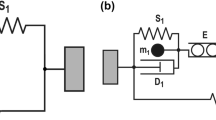Abstract
Four attempts are outlined which the author has made to develop mathematical models for topics encountered in bioengineering and rehabilitation. The first isautoregulation in the kidney, for which a nonlinear oscillator model is derived, based on observations of flow noise made by Erol Basar. The second is anonlinear observer based on the theory of automatic control, developed to study patterns of spastic torque in paralysed legs via thependulum test. The third is a design study of a skeletal muscle reflex arc involving the muscle spindle dynamics and invokingprinciple of optimum stability. The final topic is an attempt to lay the groundwork for a mathematical theory of the cross-bridge or sliding filament mechanism of muscular contraction.
Similar content being viewed by others
References
French, P. Prose, poems and parodies, Talbot Press, Dublin, 1929.
Coakley, D. Irish Masters of Medicine, Town House, Dublin, 1992.
Fox, S. I. Human Physiology. Wm. C. Brown Publishers, Dubuque, Iowa, 1994, (4th edition).
Basar, E. Biophysical and Physiological Systems Analysis, Addison-Wesley, Reading, Mass., 1976.
de Paor, A. M., Timmons, P. A feedback oscillator model for circulatory autoregulation. Int. J. Control. 1986; vol 43: 679–688.
Clynes, M. Unidirectional Rate sensitivity: a biocybernetic law of reflex and humoral systems as physiologic channels of control and communication. Ann. N Y Acad Sci 1961; 92: 946–969.
Øien, A. H., Aukland, K. Mathematical analysis of the myogenic hypothesis, with special reference to autoregulation of renal blood flow. Circ. Res 1983; 52: 241–252.
Johnson, P. C., Wayland, H. Regulation of blood flow in single capillaries. Am. J. Physiol. 1967; 212: 1405–1415.
Keane, A. M. Spasticity and Electrical stimulation in the Spinal Cord Injured. M. Med. Sc. thesis, National University of Ireland (UCD), 1994.
de Paor, A. Some contributions to Rehabilitation Engineering in Ireland. Lekar a Technika 1995; 26: 3–8.
McMillan, N. D. Rev. Samuel Haughton and the Age of the earth controversy, pp. 151–161 of Nudds, J., McMillan, N., Weaire, D., McKenna Lawlor, S. (eds). Science in Ireland 1800–1930: tradition and reform, Trinity College Dublin, 1988.
Haughton, S. Principles of Animal Mechanics, Longmans, Green, London, 1873.
Hildebrandt, S., Tromba, A. The Parsimonious Universe: shape and form in the natural world, Copernicus (Springer Verlag), New York, 1996.
Haughton, S. On the forms of the cells made by various wasps and by the honey-bee. Proc. Natural Hist. Soc. Dublin 1863; 3: 128–140.
Maxwell, J. C. On Governors. Proc. Roy. Soc. 1868; 16: 270–283.
Routh, E. J. The advanced part of a treatise on the dynamics of rigid bodies. Macmillan & Co., London, 1884 (4th edition). The stability criterion described on pp. 166–176 was first given by Routh in his Adams Prize essay at Cambridge, 1877.
de Paor, A. Fifty years of Root Locus: some new thoughts, Proceedings of the 2nd IFAC Workshop on New Trends in the Design of Control Systems, Smmolenice, Slovak Republic, September 7-190 1997, pp. 110-115.
Tyldesley, B., Grieve, J. I. Muscles, nerves and movement: Kinesiology in daily living. Blackwell Publications, Oxford, 1989.
Stark, L. Neurologic Control Systems: studies in bioengineering, Plenum Press, New York, 1968.
Granit, R. Receptors and Sensory Perception, Yale University Press, New Haven, Conn., 1955 (5th printing 1967).
Gordon, A. M., Huxley, A. F., Julian, F. J. The variation in isometric tension with sarcoMere length in vertebrate muscle fibres. J. Physiol. 1966; 184: 170–192.
Joyce, G. C., Rack, P. H. M., Westbury, D. R. The mechanical properties of cat soleus muscle during controlled lengthening and shortening movements. J. Physiol. 1969; 204: 461–474.
Murray, C. D., de Paor, A. M. Modelling the force velocity relation of muscle. Proceedings of the 17th Annual International Conference of the IEEE Engineering in Medicine and Biology Society, Montreal, Canada, September 20–23, 1995, 2pp. (Not paginated on CD-ROM).
Author information
Authors and Affiliations
Additional information
The Fourth Samuel Haughton Lecture presented to the joint meeting of the Section of Bioengineering and the Ulster Biomedical Engineering Society, Dundalk, Co. Louth, 21–22 February, 1998.
Rights and permissions
About this article
Cite this article
de Paor, A. In haughton’s footsteps: Mathematical insights into bioengineering and rehabilitation. Ir. J. Med. Sc. 167, 170–180 (1998). https://doi.org/10.1007/BF02937932
Issue Date:
DOI: https://doi.org/10.1007/BF02937932




